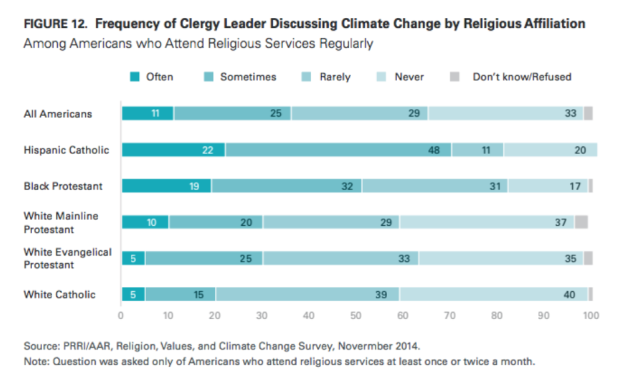Churches and other places of worship have long been breeding grounds for political activism in America: Christian fundamentalists were at the heart of the prohibition movement in the early twentieth century and black churches played a critical role in the civil rights movement. Now it appears that some clergy leaders are introducing a new issue to the pews: climate change.
 The new PRRI/AAR climate change survey found that a sizable minority of Americans who attend religious services at least once a month are hearing about climate change from their religious leaders. A little over one-third of these regular attendees say a clergy leader in their congregation speaks about the issue of climate change often (11 percent) or sometimes (25 percent), while about 6-in-10 say religious leaders discuss the issue rarely (29 percent) or never (33 percent).
The new PRRI/AAR climate change survey found that a sizable minority of Americans who attend religious services at least once a month are hearing about climate change from their religious leaders. A little over one-third of these regular attendees say a clergy leader in their congregation speaks about the issue of climate change often (11 percent) or sometimes (25 percent), while about 6-in-10 say religious leaders discuss the issue rarely (29 percent) or never (33 percent).
Indeed, organizations like Interfaith Power & Light, which encourages churches, synagogues, mosques, and temples to invest in renewable energy, are becoming more popular. Leaders from a range of faiths are taking part in conferences on the role of religion in environmental education and joining climate change protests.
But does hearing about climate change during religious services have any impact on congregants? The PRRI/AAR survey suggests that there may be a connection between hearing about climate change in services and personal beliefs about the issue. Nearly half (49 percent) of frequent attendees whose clergy leaders discuss climate change at least sometimes believe the earth is getting warmer primarily because of human activity, compared to 36 percent of frequent attendees whose clergy leaders rarely or never discuss climate change. Conversely, Americans who hear about the issue during services are less likely doubt the existence of climate change. Only 1-in-5 (20 percent) frequent attendees who hear a clergy leader discuss climate change often or sometimes are climate change Skeptics, meaning they believe there is no solid evidence the earth’s temperature is rising, while 36 percent of frequent attenders who rarely or never hear about climate change from a clergy leader are Skeptics.
These results are quite suggestive, but do not demonstrate conclusively that clergy are impacting the views of congregants on this issue. It is possible that Americans who express greater concern about the environment and climate change in particular may be self-selecting into congregations that match their views.
However, if clergy leaders speaking about climate change and places or worship promoting environmental activism are influencing the beliefs of parishioners, then the growing number of churches, synagogues, mosques, and temples promoting energy and environmental conservation may matter a great deal in the environmental movement. These environmentally friendly places of worship could serve as a critical ally for the environmental movement, which is still struggling to convince Americans of the urgent need to act on climate change.
To read the entire PRRI/AAR climate change report, click here.




